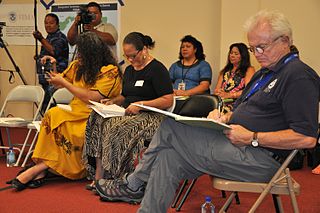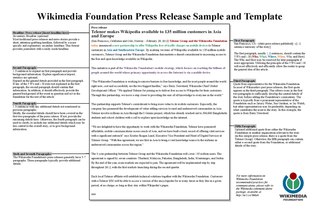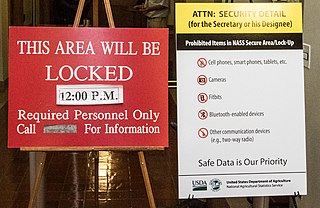Related Research Articles

Communication is usually defined as the transmission of information. The term can also refer to the message itself or the field of inquiry studying these transmissions, also known as communication studies. There are some disagreements about the precise definition of communication, for example, whether unintentional or failed transmissions are also included and whether communication does not just transmit meaning but also create it. Models of communication aim to provide a simplified overview of its main components and their interaction. Many models include the idea that a source uses a coding system to express information in the form of a message. The source uses a channel to send the message to a receiver who has to decode it in order to understand its meaning. Channels are usually discussed in terms of the senses used to perceive the message, like hearing, sight, smell, touch, and taste.
Journalism is the production and distribution of reports on the interaction of events, facts, ideas, and people that are the "news of the day" and that informs society to at least some degree of accuracy. The word, a noun, applies to the occupation, the methods of gathering information, and the organizing literary styles.

Mass media refers to a diverse array of media that reach a large audience via mass communication.

Public relations (PR) is the practice of managing and disseminating information from an individual or an organization to the public in order to influence their perception. Public relations and publicity differ in that PR is controlled internally, whereas publicity is not controlled and contributed by external parties. Public relations may include an organization or individual gaining exposure to their audiences using topics of public interest and news items that do not require direct payment. The exposure mostly is media-based. This differentiates it from advertising as a form of marketing communications. Public relations aims to create or obtain coverage for clients for free, also known as earned media, rather than paying for marketing or advertising also known as paid media. But in the early 21st century, advertising is also a part of broader PR activities.
In marketing, publicity is the public visibility or awareness for any product, service, person or organization. It may also refer to the movement of information from its source to the general public, often via the media. The subjects of publicity include people of public interest, goods and services, organizations, and works of art or entertainment.

A press release is an official statement delivered to members of the news media for the purpose of providing information, creating an official statement, or making an announcement directed for public release. Press releases are also considered a primary source, meaning they are original informants for information. A press release is traditionally composed of nine structural elements, including a headline, dateline, introduction, body, and other components. Press releases are typically delivered to news media electronically, ready to use, and often subject to "do not use before" time, known as a news embargo.
The right to privacy is an element of various legal traditions that intends to restrain governmental and private actions that threaten the privacy of individuals. Over 150 national constitutions mention the right to privacy. On 10 December 1948, the United Nations General Assembly adopted the Universal Declaration of Human Rights (UDHR), originally written to guarantee individual rights of everyone everywhere; while right to privacy does not appear in the document, many interpret this through Article 12, which states: "No one shall be subjected to arbitrary interference with his privacy, family, home or correspondence, nor to attacks upon his honour and reputation. Everyone has the right to the protection of the law against such interference or attacks."
Agenda setting describes the "ability to influence the importance placed on the topics of the public agenda". The theory suggests that the media has the ability to shape public opinion by determining what issues are given the most attention, and has been widely studied and applied to various forms of media. The study of agenda-setting describes the way media attempts to influence viewers, and establish a hierarchy of news prevalence. Nations judged to be endowed with more political power receive higher media exposure. The agenda-setting by media is driven by the media's bias on things such as politics, economy and culture, etc. The evolution of agenda-setting and laissez-faire components of communication research encouraged a fast pace growth and expansion of these perspectives. Agenda-setting has phases that need to be in a specific order in order for it to succeed.
News values are "criteria that influence the selection and presentation of events as published news." These values help explain what makes something "newsworthy."

Credibility comprises the objective and subjective components of the believability of a source or message. Credibility dates back to Aristotle theory of Rhetoric. Aristotle defines rhetoric as the ability to see what is possibly persuasive in every situation. He divided the means of persuasion into three categories, namely Ethos, Pathos, and Logos, which he believed have the capacity to influence the receiver of a message. According to Aristotle, the term "Ethos" deals with the character of the speaker. The intent of the speaker is to appear credible. In fact, the speaker's ethos is a rhetorical strategy employed by an orator whose purpose is to "inspire trust in his audience." Credibility has two key components: trustworthiness and expertise, which both have objective and subjective components. Trustworthiness is based more on subjective factors, but can include objective measurements such as established reliability. Expertise can be similarly subjectively perceived, but also includes relatively objective characteristics of the source or message. Secondary components of credibility include source dynamism (charisma) and physical attractiveness.
Journalistic ethics and standards comprise principles of ethics and good practice applicable to journalists. This subset of media ethics is known as journalism's professional "code of ethics" and the "canons of journalism". The basic codes and canons commonly appear in statements by professional journalism associations and individual print, broadcast, and online news organizations.
Mass communication is the process of imparting and exchanging information through mass media to large population segments. It is understood as relating to various forms of media, as its technologies are used for the dissemination of information, of which journalism and advertising are part. Mass communication differs from other types of communication, such as interpersonal communication and organizational communication, because it focuses on particular resources transmitting information to numerous receivers. The study of mass communication is chiefly concerned with how the content of mass communication persuades or otherwise affects the behavior, attitude, opinion, or emotion of the people receiving the information.
Media transparency, also referred to as Media Opacity, is a concept that explores how and why information subsidies are being produced, distributed and handled by media professionals, including journalists, editors, public relations practitioners, government officials, public affairs specialists, and spokespeople. In short, media transparency reflects the relationship between civilization and journalists, news sources and government. According to a textual analysis of “Information Subsidies and Agenda Building: A Study of Local Radio News”, an information subsidy is defined as “any item provided to the media in order to gain time or space”. In order to understand media transparency, one must gain an understanding of the different aspects in which media transparency is researched, understood, and explored. The following page will attempt to examine media transparency as it has grown and how it affects the modern world.

In journalism and public relations, a news embargo or press embargo is a request or requirement by a source that the information or news provided by that source not be published until a certain date or certain conditions have been met. They are often used by businesses making a product announcement, by medical journals, and by government officials announcing policy initiatives; the media is given advance knowledge of details being held secret so that reports can be prepared to coincide with the announcement date and yet still meet press time.

Gatekeeping is the process through which information is filtered for dissemination, whether for publication, broadcasting, the internet, or some other mode of communication. The academic theory of gatekeeping may be found in multiple fields of study, including communication studies, journalism, political science, and sociology. Gatekeeping originally focused on the mass media with its few-to-many dynamic. Currently, the gatekeeping theory also addresses face-to-face communication and the many-to-many dynamic inherent on the Internet. Social psychologist Kurt Lewin first instituted Gatekeeping theory in 1943. Gatekeeping occurs at all levels of the media structure—from a reporter deciding which sources are presented in a headline story to editors choosing which stories are printed or covered. Including, but not limited to, media outlet owners and advertisers.
Mediatization is a process whereby the mass media influence other sectors of society, including politics, business, culture, entertainment, sport, religion, or education. Mediatization is often understood as a process of change or a trend, similar to globalization and modernization, where the mass media are integrated to an increasing degree into other sectors of the society. Political actors, opinion makers, business organizations, civil society organizations, and others have to adapt their way of communication to a form that suits the needs and preferences of the mass media – the so-called media logic. Any person or organization who want to spread their messages to a larger audience have to adapt their messages and communication style to make it attractive for the mass media.
At various times, under its own initiative or in accordance with directives from the President of the United States or the National Security Council staff, the Central Intelligence Agency (CIA) has attempted to influence public opinion both in the United States and abroad.
Media Relations involves working with media for the purpose of informing the public of an organization's mission, policies and practices in a positive, consistent and credible manner. It can also entail developing symbiotic relationships with media outlets, journalists, bloggers, and influencers to garner publicity for an organization. Typically, this means coordinating directly with the people responsible for producing the news and features in the mass media. The goal of media relations is to maximize positive coverage in the mass media without paying for it directly through advertising.

News is information about current events. This may be provided through many different media: word of mouth, printing, postal systems, broadcasting, electronic communication, or through the testimony of observers and witnesses to events. News is sometimes called "hard news" to differentiate it from soft media.

Medical journalism is news reporting of medical news and features. Medical journalism is diverse, and reflects its audience. The main division is into (1) medical journalism for the general public, which includes medical coverage in general news publications and in specialty medical publications, and (2) medical journalism for doctors and other professionals, which often appears in peer-reviewed journals. The accuracy of medical journalism varies widely. Reviews of mass media publications have graded most stories unsatisfactory, although there were examples of excellence. Other reviews have found that most errors in mass media publications were the result of repeating errors in the original journal articles or their press releases. Some web sites, such as Columbia Journalism Review and Hippocrates Med Review, publish and review medical journalism.
References
- 1 2 Gandy, Jr., Oscar H. (1980). "Information in health: Subsidized news?". Media, Culture & Society. 2 (2): 101–115. doi:10.1177/016344378000200201. S2CID 144767055.
- ↑ Sigal, Leon V. (1973). Reporters and officials: The Organization and Politics of Newsmaking. DC Health.
- ↑ Jacobs, Geert (1999). "Self-reference in press releases". Journal of Pragmatics. 31 (2): 219–242. doi:10.1016/s0378-2166(98)00077-0.
- ↑ Zoch, Lynn M. & Molleda, Juan Carlos (2006). "Building a theoretical model of media relations using framing, information subsidies and agenda building". In Botan, C. H. & Hazleton, V. (eds.). Public Relations Theory II. Lawrence Erlbaum. pp. 279–309.